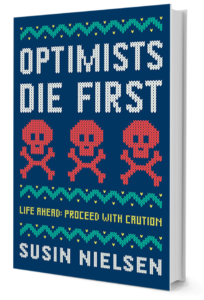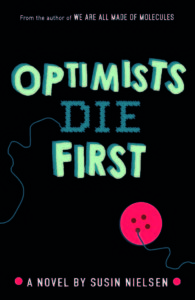 This book started with two images: Cats. And a chair with nubby colored fabric.
This book started with two images: Cats. And a chair with nubby colored fabric.
First, the chair. It was in the principal’s office of a downtown Vancouver high school. I knew that my protagonist had sat in this chair so often, she’d started thinking of it as hers. But why? As 16-year-old Petula De Wilde started to form in my head, I came to understand that she wasn’t there for typical disciplinary reasons. Something heartbreaking had happened in her life, and she feels it’s her fault. Something that has left her fearing everything from terrorists to ground beef. She has closed herself off from others, and lives her life with supreme caution.
Someone, or someones, would need to help her find her way back.
Enter my “romantic lead,” 17-year-old Jacob Cohen. For the first time in my novel-writing career, I wanted to tell a first-love story. My son, now twenty, would kill me if he knew I was sharing this, but part of what compelled me to do this was watching him fall in love for the first time at age 17, to a really lovely girl. It ended eventually, as first loves usually do (and usually should). It brought up a lot of memories, about what a wonderful, heady, exciting time that is, for so many reasons. I wanted to write about that. And to be blunt, I wanted to write about a decent, consensual, first-sex experience, because I feel it’s important that young women (and young men!) can read about positive, loving, mutually respectful portrayals of sex.
 The other someones who help Petula find her way back (and vice-versa) are her fellow Youth Art Therapy members, Ivan, Alonzo and Koula. I had a lot of fun with these supporting characters. They, and Petula and Jacob, are dealing with profound feelings of guilt, all for different reasons. They are all dealing with what if’s. And of course, there are varying degrees of guilt. Sometimes a good person can do a bad thing. How do you move forward in life with the weight of that guilt hanging over you? Other themes are ones I seem to come back to again and again: acceptance of others’ differences, and finding hope, support and friendship in unlikely places.
The other someones who help Petula find her way back (and vice-versa) are her fellow Youth Art Therapy members, Ivan, Alonzo and Koula. I had a lot of fun with these supporting characters. They, and Petula and Jacob, are dealing with profound feelings of guilt, all for different reasons. They are all dealing with what if’s. And of course, there are varying degrees of guilt. Sometimes a good person can do a bad thing. How do you move forward in life with the weight of that guilt hanging over you? Other themes are ones I seem to come back to again and again: acceptance of others’ differences, and finding hope, support and friendship in unlikely places.
For those of you who have read my other novels, you’ll know I sometimes have crossover characters. This time you’ll have to be a very observant reader to find two very minor characters from “The Reluctant Journal of Henry K. Larsen” (one of whom has a bigger role in this novel. Hint: She was on the Reach for the Top team with Henry). And one of my favourite characters, from my very first novel, does make a brief appearance at the end.
Lastly, those cats. If there is anything remotely autobiographical in this novel, it would probably be the preponderance of felines in Petula’s home. I only have two cats (Erwin Schrodinger and Emily Bronte). But if left to my own devices, I could easily swing into the stereotypical “crazy cat lady” territory. But my husband has made it very clear that our house as a two-cat max.
